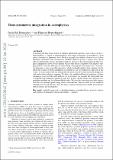Time-symmetric integration in astrophysics
Author(s)
Hernandez, David Michael; Bertschinger, Edmund
Download1708.07266.pdf (1.365Mb)
OPEN_ACCESS_POLICY
Open Access Policy
Creative Commons Attribution-Noncommercial-Share Alike
Terms of use
Metadata
Show full item recordAbstract
Calculating the long-term solution of ordinary differential equations, such as those of the N-body problem, is central to understanding a wide range of dynamics in astrophysics, from galaxy formation to planetary chaos. Because generally no analytic solution exists to these equations, researchers rely on numerical methods that are prone to various errors. In an effort to mitigate these errors, powerful symplectic integrators have been employed. But symplectic integrators can be severely limited because they are not compatible with adaptive stepping and thus they have difficulty in accommodating changing time and length scales. A promising alternative is time-reversible integration, which can handle adaptive time-stepping, but the errors due to time-reversible integration in astrophysics are less understood. The goal of this work is to study analytically and numerically the errors caused by time-reversible integration, with and without adaptive stepping. We derive the modified differential equations of these integrators to perform the error analysis. As an example, we consider the trapezoidal rule, a reversible non-symplectic integrator, and show that it gives secular energy error increase for a pendulum problem and for a Hénon-Heiles orbit. We conclude that using reversible integration does not guarantee good energy conservation and that, when possible, use of symplectic integrators is favoured. We also show that time-symmetry and time-reversibility are properties that are distinct for an integrator. Keywords: methods: numerical, celestial mechanics, planets and satellites: dynamical evolution and stability, globular clusters: general
Date issued
2018-04Department
Massachusetts Institute of Technology. Department of Physics; MIT Kavli Institute for Astrophysics and Space ResearchJournal
Monthly Notices of the Royal Astronomical Society
Publisher
Oxford University Press (OUP)
Citation
Hernandez, David M, and Edmund Bertschinger. “Time-Symmetric Integration in Astrophysics.” Monthly Notices of the Royal Astronomical Society 475, no. 4 (January 24, 2018): 5570–5584. © 2017 The Authors
Version: Author's final manuscript
ISSN
0035-8711
1365-2966